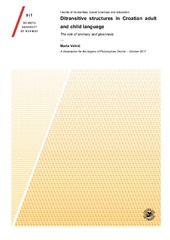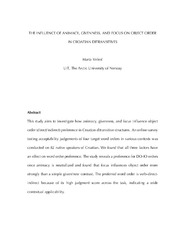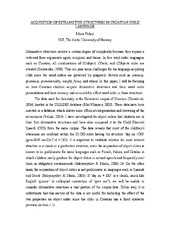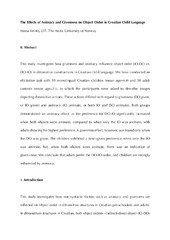| dc.contributor.advisor | Anderssen, Merete | |
| dc.contributor.author | Velnic, Marta | |
| dc.date.accessioned | 2018-02-20T11:59:10Z | |
| dc.date.available | 2018-02-20T11:59:10Z | |
| dc.date.issued | 2018-02-22 | |
| dc.description.abstract | This dissertation explores the effects that a semantic factor, animacy, and a pragmatic factor, givenness, have on the relative ordering of the two objects (IO-DO vs. DO-IO) in Croatian ditransitive structures. While the effects of animacy are explored only at a global level (object ordering), the effects of givenness are explored also in the choice of referring expressions. The effect that these factors have is explored both in adult and child language in a way that offers valuable insights for both groups. This research provides a new analysis in the acquisition of ditransitive structures as it reveals a major role of animacy in shaping children’s object order.
The results show that when the two factors are neutralised, there is an indication of DO-IO being the basic object order. Conversely, I find that the IO-DO is more frequently used both in naturalistic and in experimental data, but this frequency can be attributed to the fact that in double object structures the IO is prototypically animate and the DO is prototypically inanimate. I argue that both adults and children are sensitive to animacy, but children are more sensitive to it than adults. With regard to givenness, I find that it influences both object order and choice of referring expression in the adults, but only the choice of referring expression in the children’s data. | en_US |
| dc.description.doctoraltype | ph.d. | en_US |
| dc.description.popularabstract | This dissertation investigates how children acquire ditransitive structures in Croatian with respect to a non-contextual factor (animacy) and a contextual factor (givenness). Ditransitive sentences concern a special class of verbs called ditransitive verbs (such as 'give'), which can take three arguments: the subject, the direct object, and the indirect object. In Croatian, the choice of order of the two objects depends on the factors investigated in this research. The tested groups included children and adults and different methodologies were used: naturalistic (corpora) and experimental data, the latter was structured both in terms of comprehension (acceptability judgment task) and production (elicitation). The main finding of this dissertation is that animacy strongly affects children’s choice of word order. Adults’ preferences are also affected by it but to a lesser degree. Both adults and children favour DO-IO when animacy is controlled for, thus I suggest that DO-IO is the underlying object order in Croatian ditransitives. Additionally, the results of the papers in this dissertation suggest that children are more likely to mark givenness locally, through referring expressions, than globally, with object order. | en_US |
| dc.description.sponsorship | I am a Stipendiat and was paid by UiT during my PhD | en_US |
| dc.identifier.uri | https://hdl.handle.net/10037/12197 | |
| dc.language.iso | eng | en_US |
| dc.publisher | UiT Norges arktiske universitet | en_US |
| dc.publisher | UiT The Arctic University of Norway | en_US |
| dc.rights.accessRights | openAccess | en_US |
| dc.rights.holder | Copyright 2018 The Author(s) | |
| dc.rights.uri | https://creativecommons.org/licenses/by-nc-sa/3.0 | en_US |
| dc.rights | Attribution-NonCommercial-ShareAlike 3.0 Unported (CC BY-NC-SA 3.0) | en_US |
| dc.subject | ditransitive structures | en_US |
| dc.subject | animacy | en_US |
| dc.subject | givenness | en_US |
| dc.subject | word order | en_US |
| dc.subject | language acquisition | en_US |
| dc.subject | VDP::Humanities: 000::Linguistics: 010 | en_US |
| dc.subject | Croatian | en_US |
| dc.subject | VDP::Humaniora: 000::Språkvitenskapelige fag: 010 | en_US |
| dc.title | Ditransitive structures in Croatian adult and child language: the role of animacy and givenness | en_US |
| dc.type | Doctoral thesis | en_US |
| dc.type | Doktorgradsavhandling | en_US |


 English
English norsk
norsk




